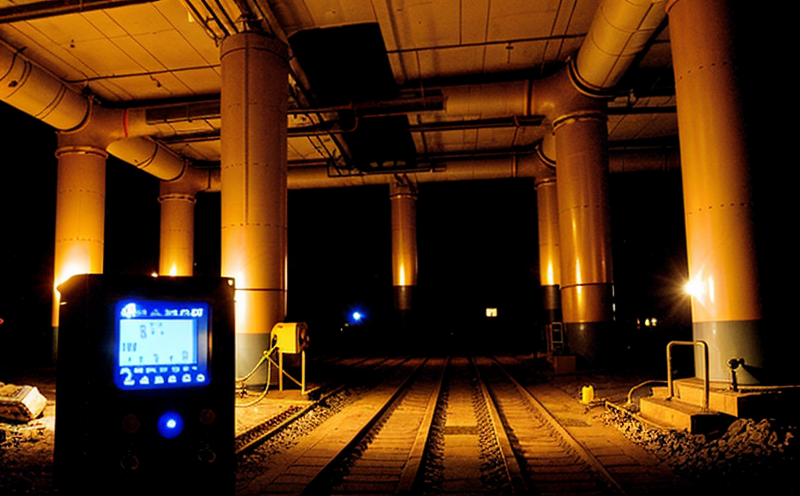ISO 11665 Radon Activity Concentration Measurement in Mines Testing
The ISO 11665 standard provides a comprehensive framework for the measurement of radon activity concentration in mines. This is critical for ensuring worker safety and compliance with international health and safety regulations.
Radon, a naturally occurring radioactive gas, can accumulate within mine environments due to its high solubility in water and ability to migrate through porous rock formations. The standard outlines the procedures required to accurately measure radon levels, which is essential for maintaining safe working conditions underground.
The testing process involves several key steps: identification of suitable sampling locations, preparation of samples, deployment of monitoring instruments, data collection, and analysis. Compliance with these procedures ensures accurate measurement and reporting of radon activity concentrations.
Sampling points should be strategically selected based on factors such as ventilation patterns, geological characteristics, and historical radon data. Instruments used for this purpose must meet specific performance criteria outlined in the ISO standard to ensure reliable readings. These instruments include alpha spectrometers or proportional counters capable of detecting low levels of radon.
Once samples are collected, they undergo rigorous analysis according to established methods described within the document. This includes calibration procedures, quality control measures, and statistical evaluation techniques designed to produce precise results.
The primary objective of this testing is to establish baseline conditions that can be used for monitoring changes over time or comparing different mine sites under similar operational parameters. By adhering strictly to the guidelines provided by ISO 11665, laboratories ensure consistent, accurate measurements which contribute significantly towards enhancing occupational health and safety standards.
For quality managers responsible for overseeing environmental controls in mining operations, this service offers valuable insights into potential risks associated with elevated radon levels. Compliance officers will find it beneficial when ensuring adherence to relevant legislation governing workplace exposure limits. R&D engineers can leverage the data generated from these tests to refine ventilation systems or develop new technologies aimed at reducing radon infiltration.
Additionally, procurement professionals involved in selecting appropriate monitoring equipment may also benefit from understanding the nuances of this testing procedure as specified by ISO 11665. Understanding these details helps them make informed decisions about purchasing high-quality instruments that meet both functional and regulatory requirements.
Applied Standards
| Standard Number | Title | Description |
|---|---|---|
| ISO 11665:2017 | Determination of radon in the ambient air, drinking water and building materials - Particular procedure for measurement of radon activity concentration in mines | This standard specifies methods for determining radon activity concentrations in various environments including mines. It covers sampling techniques, analytical procedures, quality assurance practices, and interpretation guidelines. |
| EN 12826:1999 | Determination of radon in the ambient air - Measurement procedure using alpha spectrometry or proportional counters | An alternative European standard that provides additional details on measuring radon using specific types of instruments. While not specifically limited to mine environments, it offers complementary information useful for comprehensive testing. |
| Standard Number | Title | Description |
|---|---|---|
| ASTM E1288-05 | Determination of radon in air by alpha spectrometry | This American Society for Testing and Materials standard focuses on measuring radon concentrations via alpha spectrometry. Though primarily intended for residential applications, its principles apply equally well to industrial settings like mines. |
| IEC 62315-8:2014 | Measurement of natural radioactivity in the environment - Particular procedure for measurement of radon activity concentration in mines | This International Electrotechnical Commission standard provides specific guidance on conducting measurements within confined spaces such as mines. Its focus is ensuring accurate detection even when interference from other radioactive substances might otherwise complicate readings. |
Why Choose This Test
- Ensures compliance with international standards for radon measurement in mines
- Provides accurate and reliable data on radon activity concentrations
- Supports occupational health and safety initiatives by identifying potential hazards early
- Aids in the continuous improvement of ventilation systems through informed decision-making processes
- Facilitates regulatory compliance with relevant environmental protection laws
- Promotes safer working environments for miners and other personnel operating within mine structures
- Enables proactive management strategies aimed at minimizing health risks associated with radon exposure
- Offers valuable insights into historical trends which can inform future safety protocols
Environmental and Sustainability Contributions
The ISO 11665 radon activity concentration measurement in mines testing contributes significantly to environmental protection efforts by providing accurate data on one of the primary sources of indoor air pollution. By identifying high-risk areas early, this service helps prevent unnecessary health impacts among workers while promoting sustainable practices within the mining industry.
Miners are exposed not only to harmful dust particles but also to potentially toxic gases like radon which can cause lung cancer if inhaled over prolonged periods. Through regular monitoring and intervention measures recommended based on test results, this service plays a crucial role in safeguarding public health while supporting sustainable development goals.
The continuous improvement of ventilation systems informed by these tests ensures better air quality both above ground and below surface levels. This leads to enhanced productivity among workers who are less likely to suffer from respiratory illnesses or other related ailments due to poor working conditions.





